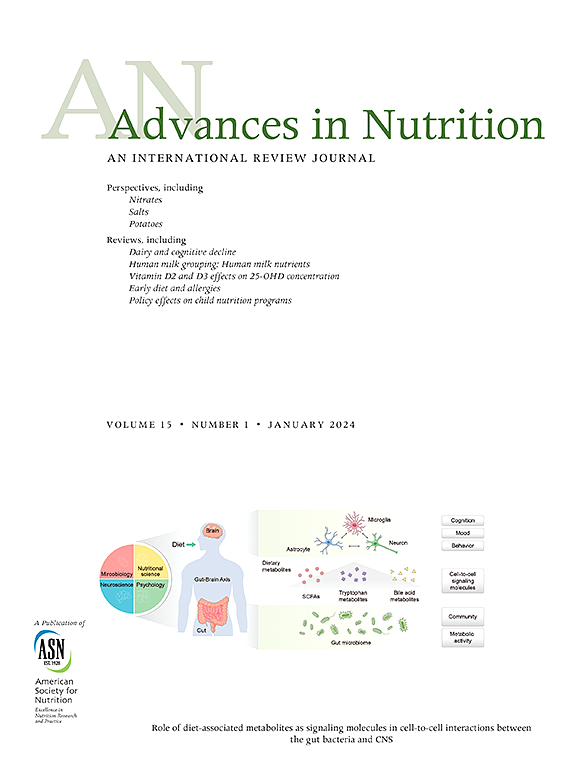揭示葡萄酒、食物和肠道健康之间关系的多组学框架。
IF 9.2
1区 医学
Q1 NUTRITION & DIETETICS
引用次数: 0
摘要
长期以来,人们一直在研究葡萄酒对心脏的保护作用,以法国悖论为例——尽管法国人的膳食胆固醇和饱和脂肪摄入量很高,但心血管疾病(CVD)发病率相对较低,这在历史上被归因于葡萄酒消费中的白藜芦醇和其他生物活性因子。最近的研究结果表明,适度饮用葡萄酒对健康的影响远远超出了心血管疾病的风险,包括对肠道生理和肠道微生物多样性和功能的影响。例如,葡萄酒含有丰富的多酚、有机酸和低聚糖,它们可能与肠道微生物群相互作用,改变微生物群落,促进葡萄酒衍生化合物的代谢,形成多种多样的异种代谢物(微生物产生的代谢物),对宿主产生局部和全身影响。这种相互作用强调了适度饮酒影响肠道和全身健康的潜在机制。此外,由于葡萄酒通常是随餐饮用的,因此有必要了解特定食物是如何与葡萄酒的化学复杂性相互作用的,从而影响肠道和全身的生理机能。这篇综述探讨了如何利用多组学技术的进步来表征葡萄酒的“暗物质”,并考虑葡萄酒成分与复杂食物基质的相互作用,从而影响肠道健康。这个框架有潜力增强我们对适度饮用葡萄酒如何影响健康的理解,并为从葡萄酒的分子成分中衍生的功能性食品创新的发展提供信息。本文章由计算机程序翻译,如有差异,请以英文原文为准。
A Multiomics Framework to Unlock the Relationships between Wine, Food, and Gut Health
Wine has long been studied for its cardioprotective effects, exemplified by the French paradox—the observation of relatively lower cardiovascular disease (CVD) rates in the French population despite high dietary cholesterol and saturated fat intake, historically attributed to resveratrol and other bioactive factors from wine consumption. Recent findings suggest that the moderate consumption of wine could impact health well beyond CVD risk, including effects on intestinal physiology and gut microbial diversity and function. For example, wine contains a rich array of polyphenols, organic acids, and oligosaccharides, which may interact with the gut microbiota to alter microbial communities and to promote metabolism of wine-derived compounds into a diverse range of xenometabolites (microbe-produced metabolites) with local and systemic effects on the host. This interplay underscores the potential mechanisms by which moderate wine consumption impacts gut and systemic health. Furthermore, because wine is often consumed with meals, there is a critical need to understand how specific foods intersect with wine’s chemical complexity to influence physiology in the gut and body-wide. This review explores how advancements in multiomics technologies can be leveraged to characterize wine’s “dark matter” and to consider interactions of wine components with complex food matrices to influence gut health. This framework holds potential to enhance our understanding of how moderate consumption of wine influences health and to inform the development of functional food innovations derived from wine’s molecular components.
求助全文
通过发布文献求助,成功后即可免费获取论文全文。
去求助
来源期刊

Advances in Nutrition
医学-营养学
CiteScore
17.40
自引率
2.20%
发文量
117
审稿时长
56 days
期刊介绍:
Advances in Nutrition (AN/Adv Nutr) publishes focused reviews on pivotal findings and recent research across all domains relevant to nutritional scientists and biomedical researchers. This encompasses nutrition-related research spanning biochemical, molecular, and genetic studies using experimental animal models, domestic animals, and human subjects. The journal also emphasizes clinical nutrition, epidemiology and public health, and nutrition education. Review articles concentrate on recent progress rather than broad historical developments.
In addition to review articles, AN includes Perspectives, Letters to the Editor, and supplements. Supplement proposals require pre-approval by the editor before submission. The journal features reports and position papers from the American Society for Nutrition, summaries of major government and foundation reports, and Nutrient Information briefs providing crucial details about dietary requirements, food sources, deficiencies, and other essential nutrient information. All submissions with scientific content undergo peer review by the Editors or their designees prior to acceptance for publication.
 求助内容:
求助内容: 应助结果提醒方式:
应助结果提醒方式:


